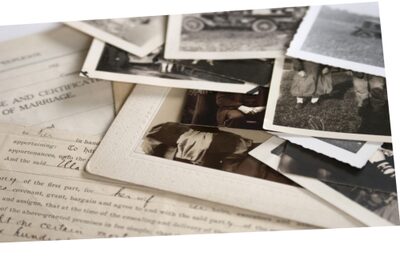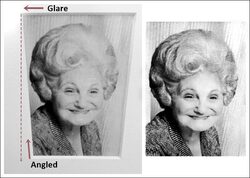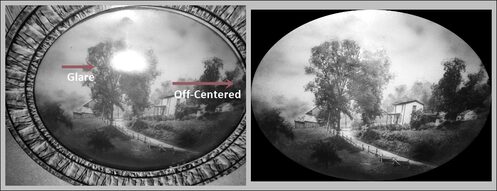Treasured Family Photos
Prevent memories from being lost and make them easily available to the rest of the family.
By Bobbi Spiker-Conley
To the family historian, few things are as treasured as a photograph. After compiling the basic facts about our ancestors, it is the vintage photos that piece together what is missing from our research.
 Now think about this. You may be the ONE person that has physical possession of an old family album or family bible. Or you may have the ONLY surviving copy of a photo that clearly documents a moment from our past. These treasures may be proudly displayed throughout your home or reverently tucked away in storage. The sad thing is that others may seldom – if ever – get the chance to enjoy them too.
Now think about this. You may be the ONE person that has physical possession of an old family album or family bible. Or you may have the ONLY surviving copy of a photo that clearly documents a moment from our past. These treasures may be proudly displayed throughout your home or reverently tucked away in storage. The sad thing is that others may seldom – if ever – get the chance to enjoy them too.
Even sadder is that old photos fade and deteriorate over the years. Their biggest enemies are light and humidity, but extreme heat and cold, insects, and general mishandling (everything from oils on your hands to improper storage techniques) also cause considerable damage.
So how can we prevent these memories from being lost and make them easily available to the rest of our family? One solution is to digitally preserve them with an imaging device such as a scanner, then backup and distribute copies.
There are many types scanners on the market. Each does one or two things really well; none (in my opinion) does everything equally well. Therefore, the “best” scanners are the ones that meet your needs. Do you prefer something small and mobile? Do you require an automatic feeder to conquer stacks of loose documents? Do you need the ability to create searchable PDFs or to stitch together multiple images? Head over to the family’s General Store for a list of “scanners by type”. Look through the inventory, compare models, read reviews. Discover which is best for your situation.

Scanning flat items such as photos and documents is easy, but not everyone has access to a scanner. Alternatively, taking “pictures of pictures” can provide surprisingly good results. Here are a few tips.
- Take your time and plan your shot well.
- Turn off your flash.
- If possible, remove framed photos to avoid reflection from the glass.
- Place your photo on a flat surface such as a table.
- Take advantage of ambient light but watch for unwanted glare.
- Make sure the photo is “square” with the camera view.
- Take multiple shots from slightly different positions.
 Many of the photos we use on this site – like these of Gracie Spiker and of the Sophie House – are “pictures of pictures” that were emailed to us. Notice how they are improved by “squaring up” the photo with what is seen through the camera’s lens.
Many of the photos we use on this site – like these of Gracie Spiker and of the Sophie House – are “pictures of pictures” that were emailed to us. Notice how they are improved by “squaring up” the photo with what is seen through the camera’s lens.
Still not sure you can capture a quality reproduction? Experiment with any of the scanner apps available for Apple and Android smart devices. It’s like having a portable scanner in your pocket.
Two of our favorites are Google’s PhotoScan and Microsoft’s Office Lens. They can automatically detect edges, straighten images, correct perspective, remove glare, and save your images directly to Google Photos or Microsoft’s OneDrive, respectively. Oh, did I mention…they’re both FREE!!!
As I see it, you no longer have any excuses for keeping those family photos hidden away. Scan them now. Make notes (you may be the only one that can identify the people, provide the context, or explain why the image is important to our family story,) and share them with the rest of us. Make copies and back them up – to CDs, DVDs, hard drives, portable drives, online backups, photo storage sites, the cloud, everywhere. If one storage options fails, degrades, becomes obsolete or goes out of business in a few years, you’ll be relieved to know copies of your files are safe elsewhere.
So what are you waiting for? Get to work. Scan your pics, upload them to your favorite online service, and send me the link.
Announcements
- Submitted by Bobbi Spiker Conley – This is the first in a series of articles about preserving our family history. Be sure to stop by next month when we discuss Treasured Family Heirlooms.